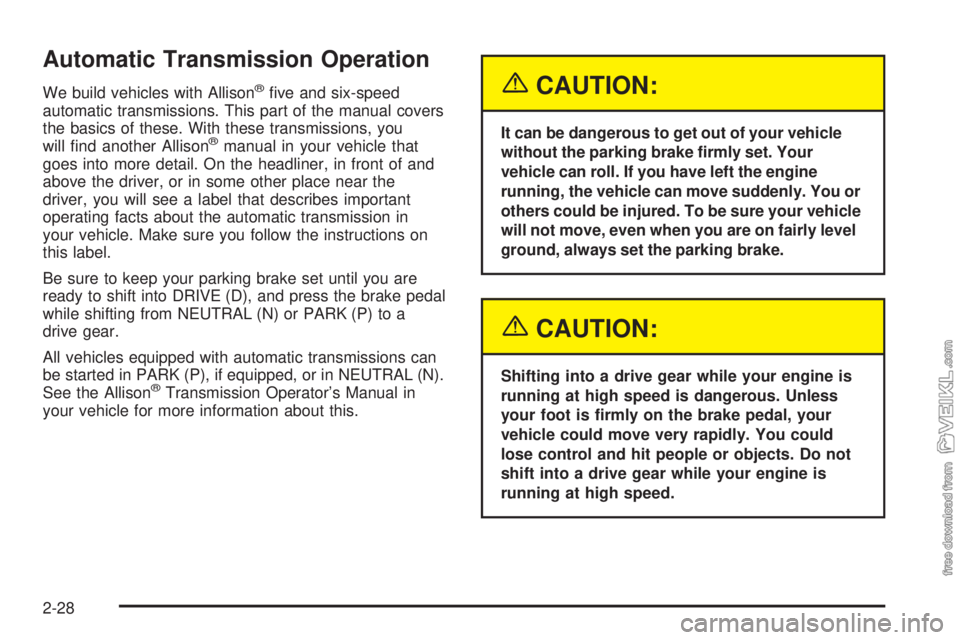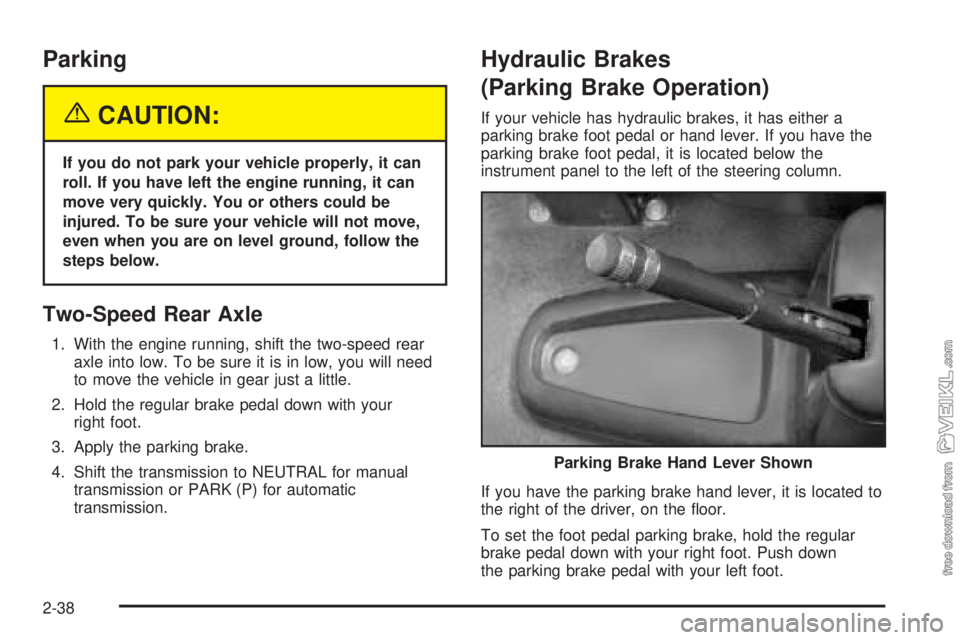Page 88 of 374

The high idle speed will be temporarily interrupted and
the engine speed will return to normal if any of the
following conditions occur:
•The brake pedal is applied.
•The accelerator pedal is pressed.
•The automatic transmission is shifted out of
PARK (P) or NEUTRAL (N).
•The clutch pedal on the manual transmission is
pressed.
•Vehicle speed is detected.
Once these inputs are removed, the engine idle speed
will slowly ramp back up to high idle after the normal
delay, if the conditions for engine coolant temperature
and air intake temperature are still met.
If this feature is turned off, by doing the brake stomp
procedure described above, and then the engine
is started the exhaust brake/restrictor light will flash for
10 seconds and then it will turn off.
Engine Checks Before Operating
When you have started your engine, let it run for
20 to 30 seconds before you put a load on the engine.
But do not leave the vehicle while the engine is running.
Avoid unnecessary idling of diesel engine equipped
vehicles.
If the engine idles too long, the temperature of the
engine coolant will fall below the normal operating
range. Low engine operating temperature causes
several conditions which affect engine operation and
reduce engine life.
The engine should be permitted to go through a
warm-up period. Operate the vehicle at a minimum of
600 rpm during the warm-up period. During this
period and during operation, the following observations
should be made.
2-22
Page 92 of 374

Two-Speed Rear Axle Electric
Shift Control
If your vehicle is equipped with this feature, you will find
a label on the headliner above the windshield or in
another place near the driver that shows how to use it.
Be sure to follow the directions carefully.
Use the following directions based on the type of shift
control you have.
The rear axle shift control
switch for a manual
transmission is located
on the shift lever.When the switch is up, the rear axle is in the high
range. Push the switch down to change to low range.
The two-speed axle should be in low when you park
the vehicle. You will need to engage the transmission,
even move the vehicle a little, to be sure the axle is
in the low range. Then apply the parking brake, shift into
NEUTRAL and shut off the engine.
Also, always start the vehicle in motion with the
two-speed axle in the low range. To shift up from low
to high, do the following:
1. Move the switch up for the high range,
2. disengage the clutch, and
3. after a brief pause, engage the clutch and then
press down on the accelerator.
To shift down from high to low, do the following:
1. Move the switch down to low,
2. release the accelerator and then quickly
apply it again.
2-26
Page 94 of 374

Automatic Transmission Operation
We build vehicles with Allison®five and six-speed
automatic transmissions. This part of the manual covers
the basics of these. With these transmissions, you
will find another Allison
®manual in your vehicle that
goes into more detail. On the headliner, in front of and
above the driver, or in some other place near the
driver, you will see a label that describes important
operating facts about the automatic transmission in
your vehicle. Make sure you follow the instructions on
this label.
Be sure to keep your parking brake set until you are
ready to shift into DRIVE (D), and press the brake pedal
while shifting from NEUTRAL (N) or PARK (P) to a
drive gear.
All vehicles equipped with automatic transmissions can
be started in PARK (P), if equipped, or in NEUTRAL (N).
See the Allison
®Transmission Operator’s Manual in
your vehicle for more information about this.
{CAUTION:
It can be dangerous to get out of your vehicle
without the parking brake �rmly set. Your
vehicle can roll. If you have left the engine
running, the vehicle can move suddenly. You or
others could be injured. To be sure your vehicle
will not move, even when you are on fairly level
ground, always set the parking brake.
{CAUTION:
Shifting into a drive gear while your engine is
running at high speed is dangerous. Unless
your foot is �rmly on the brake pedal, your
vehicle could move very rapidly. You could
lose control and hit people or objects. Do not
shift into a drive gear while your engine is
running at high speed.
2-28
Page 95 of 374

Overdrive Defeat
If your vehicle has this feature, you can select not to
shift up to fifth gear. This is useful when towing or under
a heavy load.
The overdrive defeat
switch is located in the
instrument panel to
the right of the
steering column.
Press the switch to limit the transmission to fourth gear.
This will allow for fewer downshifts while pulling a
trailer or under a heavy load. The indicator light in the
switch will come on whenever overdrive defeat is active.
Manual Transmission Operation
Using the Clutch
When you are starting to move the vehicle, it is
important to begin with the engine speed at idle.
Then start to engage the clutch and listen for an engine
speed drop of about 100 rpm. At this point, the clutch
is engaging, so you should increase the engine speed
and fully engage the clutch. It is important not to
increase the engine speed sooner or before the clutch
begins its engagement. If you do, you can cause
damage to your vehicle.
Double-Clutching
You must use the double-clutching method when you
shift an unsynchronized gear set. Disengage the clutch,
shift to NEUTRAL and engage the clutch. When
upshifting, slow the engine until the engine rpm and
road speed match. When downshifting, accelerate the
engine until the engine rpm and road speed match.
Then quickly disengage the clutch and move the shift
lever to the next gear position and engage the clutch.
2-29
Page 96 of 374

Eaton®Fuller®Five and Six-Speed
Transmissions and TTC Spicer
Seven-Speed Transmissions
These transmissions have gears that automatically
synchronize when you shift up or down (except
FIRST (1) gear on the five-speed and seven-speed
transmission which is unsynchronized). Choose the
gear that will maintain the road speed you want while
keeping the engine above two-thirds of the governed
speed. When the engine speed drops below two-thirds
of the governed speed, shift into the next lower gear
before your engine begins to lug. When you shift down,
be sure to double-clutch if required.
ZF Six-Speed Transmission
Here is how to operate your transmission.
This six-speed pattern is
unique to GM manual
transmissions.
The transmission always repositions the shift lever to
NEUTRAL, which is located between FOURTH (4)
and FIFTH (5) gear.
To prevent unintentional gear selections, additional force
is required to move the shift lever into REVERSE (R) or
FIRST (1). Use FIRST (1) when trailer towing, driving
with a heavier payload or launching on a grade.
Otherwise, start in SECOND (2) gear. Only shift into
FIRST (1) when the vehicle has stopped moving.
2-30
Page 98 of 374

Eaton®Fuller®Nine and Ten-Speed
Non-Synchronized Manual
Transmissions
If your vehicle has one of these transmissions the
engine rpm and road speed must match when upshifting
and downshifting. The label above the windshield will
tell you the operating basics you need to know.
The following are driving tips.
•Always choose an initial starting gear suitable for
the load and terrain.
•Always use double-clutching procedures when
shifting.
•Never move the range shift lever to the LO speed
gear position after HI range preselection, or
anytime the transmission is in the HI range.
•Never move the range knob or lever with the shift
lever in NEUTRAL while the vehicle is moving.
•Never make a range shift while moving in
REVERSE (R).
Clutch Brake (Vehicles with
Non-Synchronized Transmission)
A clutch brake is used to stop transmission input shaft
rotation so that FIRST (1) or REVERSE (R) gear
selection can be initiated when the vehicle is at a
standstill and the engine is idling.
Press the clutch pedal all the way down to the floorboard
to apply the clutch brake.
When using the clutch brake, disengage the clutch
pedal and shift the transmission into either the initial
starting gear or REVERSE (R). If the tooth-butting
occurs between the clutching teeth, re-engage the clutch
while applying light pressure to the shift lever. This
will provide for a smooth shift into either FIRST (1) or
REVERSE (R) gear.
Notice:Using the clutch brake for shifting into any
gear other than FIRST (1) or REVERSE (R) may
cause premature wear of the clutch brake and make
gear shift effort more difficult. Do not use the
clutch brake for shifting after engaging FIRST (1) or
REVERSE (R).
2-32
Page 104 of 374

Parking
{CAUTION:
If you do not park your vehicle properly, it can
roll. If you have left the engine running, it can
move very quickly. You or others could be
injured. To be sure your vehicle will not move,
even when you are on level ground, follow the
steps below.
Two-Speed Rear Axle
1. With the engine running, shift the two-speed rear
axle into low. To be sure it is in low, you will need
to move the vehicle in gear just a little.
2. Hold the regular brake pedal down with your
right foot.
3. Apply the parking brake.
4. Shift the transmission to NEUTRAL for manual
transmission or PARK (P) for automatic
transmission.
Hydraulic Brakes
(Parking Brake Operation)
If your vehicle has hydraulic brakes, it has either a
parking brake foot pedal or hand lever. If you have the
parking brake foot pedal, it is located below the
instrument panel to the left of the steering column.
If you have the parking brake hand lever, it is located to
the right of the driver, on the floor.
To set the foot pedal parking brake, hold the regular
brake pedal down with your right foot. Push down
the parking brake pedal with your left foot.Parking Brake Hand Lever Shown
2-38
Page 110 of 374

Running the Engine While Parked
It is better not to park with the engine running. But if you
ever have to, here are some things to know.
{CAUTION:
Idling the engine with the climate control
system off could allow dangerous exhaust into
your vehicle. See the earlier caution under
Engine Exhaust on page 2-43.
Also, idling in a closed-in place can let deadly
carbon monoxide (CO) into your vehicle even if
the climate control fan is at the highest setting.
One place this can happen is a garage.
Exhaust — with CO — can come in easily.
NEVER park in a garage with the engine
running.
Another closed-in place can be a blizzard.
SeeWinter Driving on page 4-26.
{CAUTION:
It can be dangerous to get out of your vehicle
if the automatic transmission shift lever is not
fully in PARK (P) with the parking brake �rmly
set. Your vehicle can roll. Do not leave your
vehicle when the engine is running unless you
have to. If you have left the engine running,
the vehicle can move suddenly. You or others
could be injured. To be sure your vehicle will
not move, even when it is on fairly level
ground, always set the parking brake and
move the automatic transmission shift lever
to PARK (P), or the manual transmission
shift lever to NEUTRAL.
Follow the proper steps to be sure your vehicle
will not move.
2-44